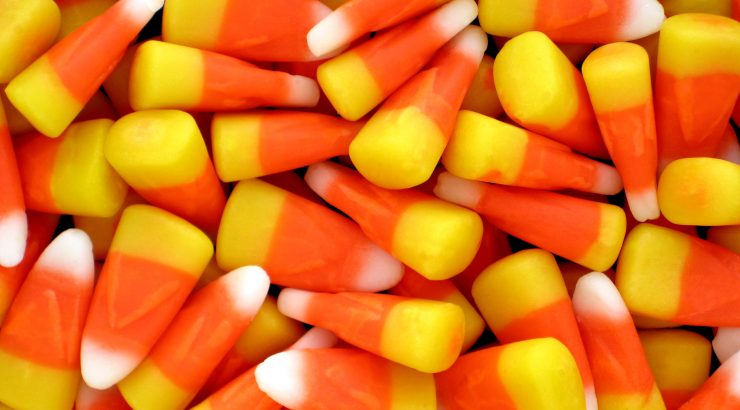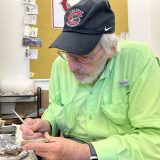TRICK or TREAT! What are you actually eating this Halloween? by Natalie Tom, Food Science student
October 28, 2016

“TRICK or TREAT!!” screamed a bunch of children as soon as I opened the front door. I began distributing handfuls of candy to these little kids giving the most candy to the kid with the best costume, of course. As I closed the door, I reach for my favorite candy and cracked it open while I waited for the next wave of Jack Sparrows and Elsa’s to arrive. Halloween is awesome because it is the only day of the year where it is acceptable to eat a ton of candy in one sitting regardless of your age. It is a day to treat yourself and to disregard all those P90x or hot yoga sessions that lead up to this moment. However, as consumers and candy lovers, we tend to refer to these packaged goods as rewards and as treats. But what if these delicious morsels were not the assumed positive outcome of the “trick or treat” plea? What if these candies were not only fulfilling their “treat” aspect, but their “trick” destiny as well? What are we actually handing out to the kids this Halloween? After analyzing and researching the top ingredients of these Halloween candies, you can see for yourself whether or not YOU are being tricked.
Candy Corn
There are two hidden secrets about this his yellow, orange, and white candy. First of all, it certainly is not a vegetable. I know that this may come as a surprise to some of you. Trust me, I’ve been there. Just because it has the word corn in it does not mean it is actually corn and it definitely does not mean that it is healthy. Yes, false advertisement is just the worst, isn’t it? Second of all, candy corn actually contains an ingredient called shellac.
Shellac
is a sticky substance secreted by the female lac bug (picture an uglier version of a ladybug with no spots). Typically, shellac is processed into dry flakes and then dissolved in ethanol to create the shiny, hard,
glazed coating
on the outside of candy corn. Typically, you’ll see this ingredient labeled as “
confectioners glaze
.” This directly refers to “secretions from a bug native to Thailand.” Confectioners glaze is just a sweeter, simpler, and more appetizing title, so companies choose to list the ingredient as that.
Alright. That wasn’t too bad, right? Let’s continue…
Starbursts
This UNEXPLAINABLY JUICY candy definitely lives up to its slogan. It is juicy, chewy, and it has every desirable flavor that one could want. What can be better than that? Well, let me tell you some juicy details that you may not be aware of. Starburst candy has an ingredient called
gelatin
that is used as a thickener and stabilizing agent. You’ve probably heard of it before (it is in Jello), but what you might not know is that gelatin is a protein derived from the collagen in cow/pig bones, skin, and connective tissues. But wait, I’m not done. Who’s a fan of the raspberry flavored Starburst? Raise your hands up loud and proud, because you are actually eating a combination of castor and anal gland secretions straight from a beaver, called castoreum. YUP, I said it – YOU’RE EATING beaver butt goo. YUM. It cannot get any better than that folks.
Castoreum
is a substance with a strong penetrating odor that is used to make most artificial raspberry flavors. So, the next time you eat a Starburst, remember this: you’re eating cow bones and possibly beaver butt goo.
Well, that was exciting! Now, on to the next…
Skittles
Taste the Rainbow! At this point of our lives, we’ve all tasted the rainbow at least once. Which part of the rainbow do you like best? If it is the red one, congratulations! You are the chosen one. Red skittles have an ingredient called carmine that creates a red dye.
Carmine
is made from the extracts of dried bodies of a beetle like insect called a Coccus cacti bug. Didn’t know there were bugs in your skittles, huh? Surprise!
Now it is time to leave the bugs and animals behind, and to move on to bigger and better things.
M&M’s
These chocolate morsels surely do “melt in your mouth, not in your hand” (if you eat them fast enough). We assume that what is melting in our mouths is chocolate, but there is another component. M&M’s have an ingredient called dextrin that acts as a thickener and adds to the viscosity of the product.
Dextrin
is a water-soluble glue that is used as an adhesive for re-sealable envelopes. It is also used in dyes and paint.
Last but not least…
Reese’s Peanut Butter Cup
This peanut-buttery sensation is one of the Top 5 Best Selling Candies in the World! And I am not surprised one bit. Who would ever reject a beautiful cup of peanut butter and chocolate? So why did I bring this candy up? Unfortunately, Reese’s Peanut Butter Cups and lighter fluid seem to have one ingredient in common
: tert-Butylhydroquinone
or TBHQ for short. TBHQ is an aromatic organic compound that is used as a preservative to extend the shelf life of candy. Does this mean that if I eat a Reese’s, my mouth is going to ignite? Well no, your mouth is not going to catch on fire. The only thing the Reese’s will ignite is your heart, because you WILL fall in love with this candy.
So Natalie, I feel like I’ve been tricked rather than treated these past Halloweens. Should I just stop eating candy forever?
No! There’s no need to let one ingredient in your candy that is present is such minimal quantities stop you from eating something you love or crave from time to time! These ingredients have been in your candy for years and years and there have been no detrimental effects. You are still alive and well after eating these candies. Trust me, you’ll be fine! Treat yourself this Halloween.
This article is part of our on-going series “The Science of Food” which is comprised of essays from students in the M.S. in Food Science program at Chapman University. The essay was originally published on the Food Science Student Association’s blog, which you can read here: http://chapmanfsnsa.blogspot.com/.
References
Adams M. 2011. Confectioner’s Glaze, a Common Coating on Candies and Pills, is Made from the Bodily Excretions of an Asian Beetle. Natural News. Available from:
http://www.naturalnews.com/033217_confectioners_glaze_shellac.html
. Accessed 2016 Sept 14.
Burdock GA. 2007. Safety Assessment of Castoreum Extract as a Food Ingredient. International Journal of Toxicology 26(1): 51-55.
Eisley J. 2009. An Interview with Joe Eisley, National Starch Food Innovation. Candy Industry. Available from:
http://www.candyindustry.com/articles/83448-an-interview-with-joe-eisley-national-starch-food-innovation
. Accessed on 2016 Sept 17.
Hagenmaier RD, Grohmann K. 1999. Polyvinyl Acetate as a High-Gloss Edible Coating. Journal of Food Science 64(6): 1064-1067.
Mishler B. 2012. 5 Scary Ingredients You Might Wanna Know About. Sparknotes. Available from:
http://www.sparknotes.com/mindhut/2012/11/09/5-scary-ingredients-in-candy-you-might-wanna-know-more-about
. Accessed 2016 Sept 15.
Munoz-Colmenero M, Martinez JL, Roca A, Garcia-Vazquez E. 2016. Detection of Different DNA Animal Species in Commercial Candy Products. Journal of Food Science 81(3): T801-T809.
Ryan S. 2015. Hidden Ingredients in Candy and What They Really Are. Greenopedia. Available from:
http://greenopedia.com/ingredients-candy-gum/
. Accessed 2016 Sept 17.
United States Consensus Bureau. 2014. Facts for Features: Halloween Oct 31, 2014. Newsroom. Available from:
http://www.census.gov/newsroom/facts-for-features/2014/cb14-ff23.html
. Accessed on 2016 Sept 15.
Yilmaz UT. Ergun F. Yilmaz H. 2014. Determination of the Food Dye Carmine in Milk and Candy Products by Differential Pulse Polarography. Journal of Food and Drug Analysis 22(3): 329-335.
This article is part of our on-going series “The Science of Food” which is comprised of essays from students in the M.S. in Food Science program at Chapman University (
http://www.chapman.edu/scst/graduate/ms-food-science/index.aspx
). The essay was originally published on the Food Science Student Association’s blog, which you can read here:
http://chapmanfsnsa.blogspot.com/
.


